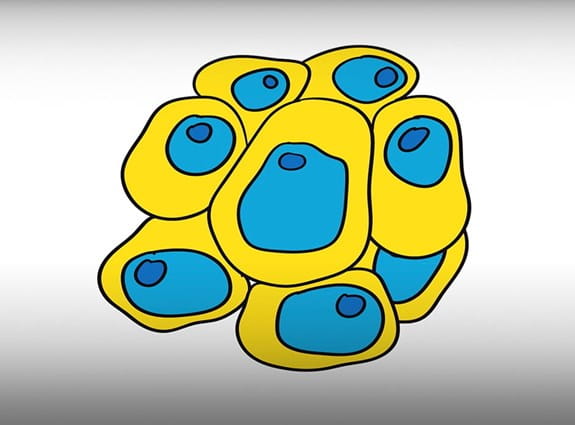What is cancer?
[The narrator appears on screen next to the title. She is an oncologist.]
Narrator: Did you know that cancer isn't one disease? It's more than 100. But all cancers have something in common, and this video explains what it is.
[The narrator and title disappear. A cell appears on screen. It shows the basic structures inside a cell.]
Narrator: Cancer is a disease that starts in our cells.
[The detailed cell transforms itself into a simple cell. More and more cells appear next to it until they fill the screen.]
Narrator: Our bodies are made up of trillions of cells, grouped together to form tissues and organs such as muscles and bones, the lungs and the liver.
[The cells move into 3 groups at the top of the screen. Below the first group of cells appears an illustration of a bone with a muscle on it. Below the second group of cells, an illustration of the lungs appears. Below the third group of cells, an illustration of the liver appears.]
Narrator: Genes inside each cell tell it to grow, work, divide and die.
[A pair of genes appear on the screen. They each look like the letter X. Next to the genes, a double helix of DNA appears. Then a megaphone appears. From the megaphone, different speech bubbles appear. The first shows arrows that represent growth. The second speech bubble shows the lungs, which represent work. The third speech bubble shows cells, which represent dividing. The last shows a brown, misshapen cell that represents death.]
Narrator: Normally, our cells follow these orders, and we remain healthy.
[Cells appear inside the speech bubbles. Arrows indicate that the cells are following orders to grow and divide.]
Narrator: But sometimes the instructions in some cells get mixed up and these cells start to grow and divide uncontrollably.
[Some of the cells in the speech bubbles become misshaped. Then the illustrations disappear, and a single cell appears on screen. More and more cells appear behind the cell, showing that it is dividing in an uncontrolled way.]
Narrator: Over time, the abnormal cells may form a lump, or tumour.
[Some of the cells form a group that gets bigger, representing a tumour.]
Narrator: Some tumours are non-cancerous and some are cancerous.
[The cells disappear and the oncologist appears on screen.]
Narrator: Cells that aren't cancerous stay in one place in the body and are not usually life-threatening.
[A simple outline of a human body appears next to the oncologist. There is a yellow spot on the abdomen of the figure.]
Narrator: Cells that are cancerous, however, can grow into nearby tissues and spread to other parts of the body. Cancer cells that spread to other parts of the body are called metastases.
[The oncologist disappears, and the screen zooms in to the illustration of the human body. The yellow spot on the figure gets larger. Then smaller yellow spots appear next to it and in the neck. More spots appear in the neck, under the arms, in the chest and in the groin.]
Narrator: The first sign that cancer has spread, or metastasized, is often swelling of nearby lymph nodes, like those in the neck, underarm or groin areas. But cancer can spread almost anywhere in the body.
[An illustration of a person’s head and neck in profile appears. There are yellow spots behind the chin and in the neck. This illustration becomes smaller and shifts to the top-left of the screen. More yellow spots appear on the neck. An illustration showing yellow spots in the armpit appears at the top-right of the screen. An illustration showing yellow dots in the groin appears at the bottom-centre of the screen.]
Narrator: Cancers are named after the part of the body where they start. For example, cancer that starts in the bladder but spreads to the lung is called bladder cancer with lung metastases.
[The oncologist appears on screen.]
Narrator: To find out more about cancer, visit the Canadian Cancer Society online at cancer.ca or call 1-888-939-3333.
[On the left of the screen, the Canadian Cancer Society logo appears above the contact number and website. On the right of the screen, the BMO bank logo appears as a proud sponsor of the Cancer Basics videos.]

